
The Kunstkamera is a modern scientific center with a public museum of anthropology and ethnography with archaeological finds from Russia and other countries of the world, located in St. Petersburg on the south-eastern edge of Vasilievsky Island (Universitetskaya Embankment).
Full name of the museum: Peter the Great Museum of Anthropology and Ethnography (Kunstkamera) of the Russian Academy of Sciences (MAE RAS).
Kunstkammer (from the German Kunstkammer-room of art) - in the past, the name of various historical, artistic, natural-scientific and other collections of rarities and places of their storage.
The Kunstkamera in St. Petersburg was founded by Peter I in 1714. The tsar's order was connected with the decision to move from Moscow to the new capital of the Russian Empire the personal collection of collections and the library of Peter the Great, as well as the books and collections of the "naturalia" of the Apothecary's Office, including those acquired by Peter during the Great Embassy to Europe.
Almost simultaneously with the organization of the museum, the design and construction of a special building for the museum was started in 1718-1727 in the style of the so-called "Peter's Baroque". The site for the construction of the museum building was chosen by Peter I himself on the banks of the Neva River. Initially, the construction was led by the German architect and sculptor Georg Johann Mattarnovi, since 1917-by the Swiss architectural engineer Nikolaus Friedrich Gerbel, and since 1724-by the architect Gaetano Chiaveri.
After its construction, the building of the Kunstkamera became the first stone public building in St. Petersburg and the second in Europe, built specifically for the museum, and also united the library, collections, anatomical theater and astronomical observatory into a single complex, creating the basis of the Academy of Sciences, established by Peter I in 1724.
Subsequently, the building underwent restorations.
Today, the Kunstkamera building is considered to be one of the earliest museum buildings in the world, as well as the symbol and logo of the Russian Academy of Sciences. The building is decorated with an arrow of Vasilievsky Island.
The Kunstkamera is crowned by a tower with an armillary sphere, symbolizing the model of the Solar system. The tower of the building is one of the business cards and a symbol of St. Petersburg.
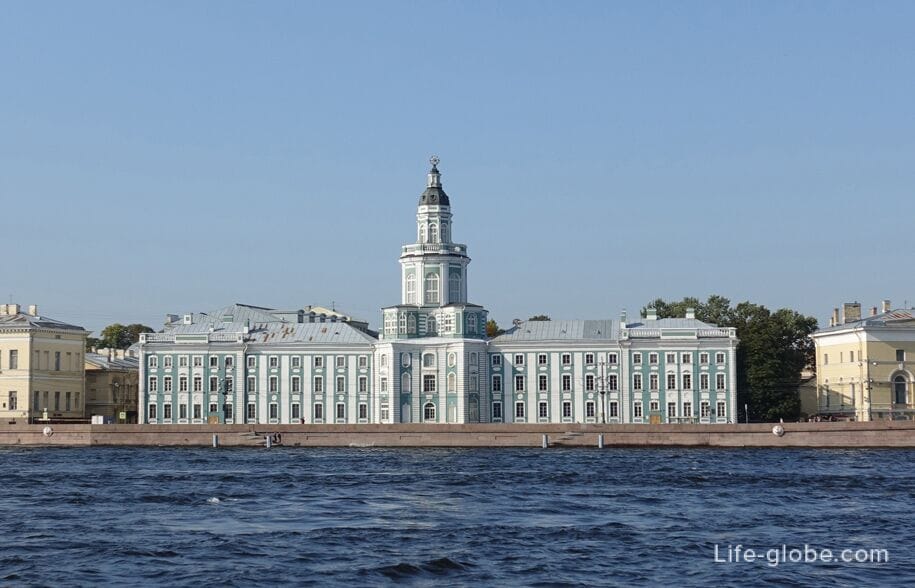
Photo of the kunstkamera in the ensemble of other buildings on the University embankment
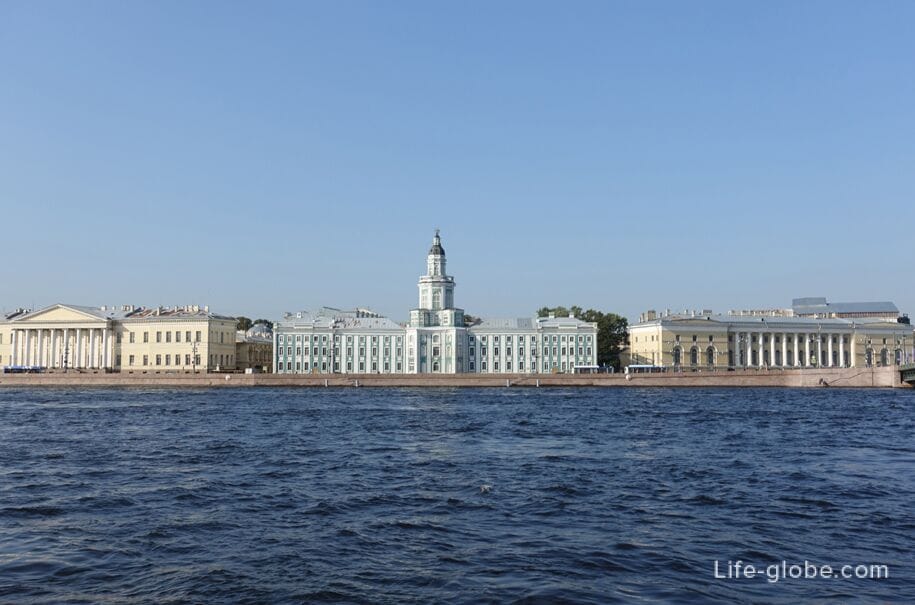
Now the Peter the Great Museum of Anthropology and Ethnography (Kunstkamera) of the Russian Academy of Sciences is not only an academic museum, but also one of the leading research centers of the Russian Academy of Sciences.
The museum's collections over the history of the Kunstkamera grew, and continued to be supplemented.
Today, the Kunstkamera is one of the largest and oldest ethnographic museums in the world, with collections of over 1.2 million exhibits reflecting the diversity of human cultures.
The museum's collections include priceless ethnographic, anthropological, and archaeological exhibits that are among the most comprehensive and interesting in the world.
The museum's expositions are located on several floors of the Kunstkamera building:
You can view the features of the internal architecture of the building, its interiors and even some exhibits on the layout, created from sources of the 18th century and representing this architectural monument in the context.
Numerous engravings and photographs of the collection, together with a dynamic electronic presentation, represent the three-hundred-year history of the Kunstkammer building.
The exhibition hall itself is an important part of the museum - its vaults are richly decorated with decorative stucco of the 18th century.
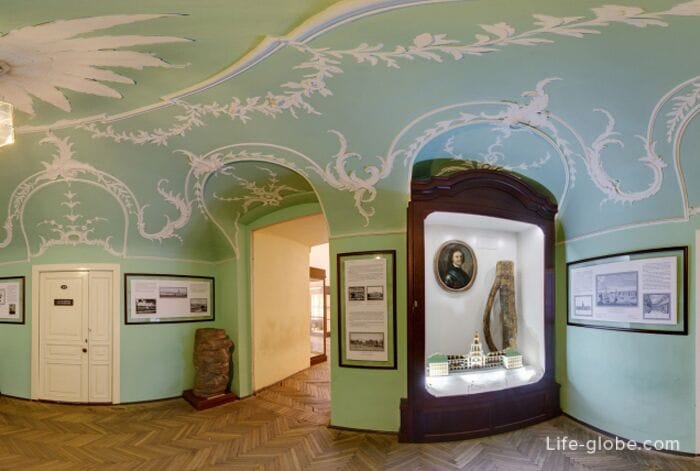
The exhibition "North America" tells about the traditional culture of the American Indians of the first half of the 19th century (from Alaska to California).
The exhibition presents: turning kayaks and harpoons, Stateline skiing and snow of the home, sleds and fur parks (products Eskimos and Aleuts, the great hunters of the Arctic); Aleutian wooden headgear for marine hunt; suede clothing athapaskan, embroidered from the needles of a porcupine; items of equipment lenkiski warriors and attributes lenkiski shamans; ritual costumes from bird feathers and wicker baskets California Indians; ceramics and fabrics Pueblo.
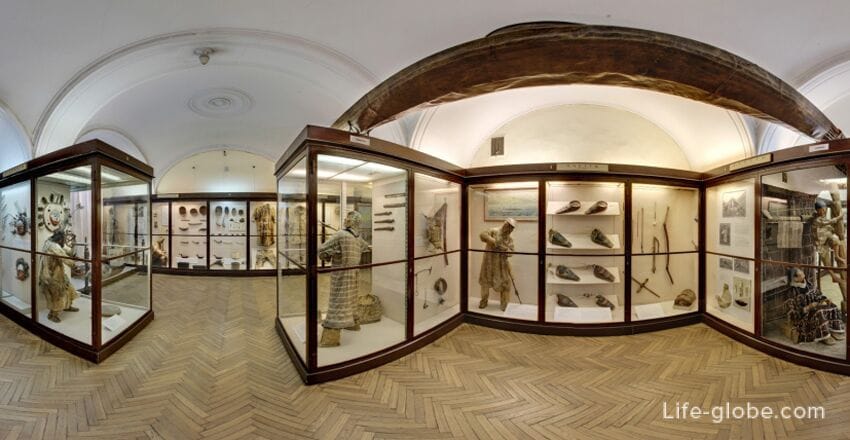
The exhibition "Latin America" is dedicated to the traditional culture of the indigenous peoples of Latin America.
The earliest exhibits date back to the second half of the 18th century, and the collection also includes exhibits from the 19th-early 20th centuries and folk art from Mexico and Guatemala in the third quarter of the 20th century.
In the exhibition, including submitted: shirts and cloth bast matter, which the Indians of the Northwest Amazon used in rituals; samples of Indian art caduveo living on the border of Brazil and Paraguay; Peruvian wooden cups from the mid-19th century; the costume of the shaman and shamanic origin of the Indians of Western Mexico; head trophies Indians and munduruku of Shuar.
Unique and rare exhibits include: the ceremonial costume of the leader and feather ornaments brought from central Brazil by the expedition of Academician G. I. Langsdorf (1821-1828), as well as the costume of the shaman chamacoco (Paraguay) of the early 20th century.

The exhibition, dedicated to Africa, presents the culture of Christian Ethiopia, the savannahs of Western Sudan, the peoples of the upper Nile and Central Africa.
The pearl of the exhibition is "Beninese bronze": cast images of courtiers, rulers of Benin and their mothers, animals.
The hall also displays items from everyday and important events in people's lives, occult practices, wars and recreation.
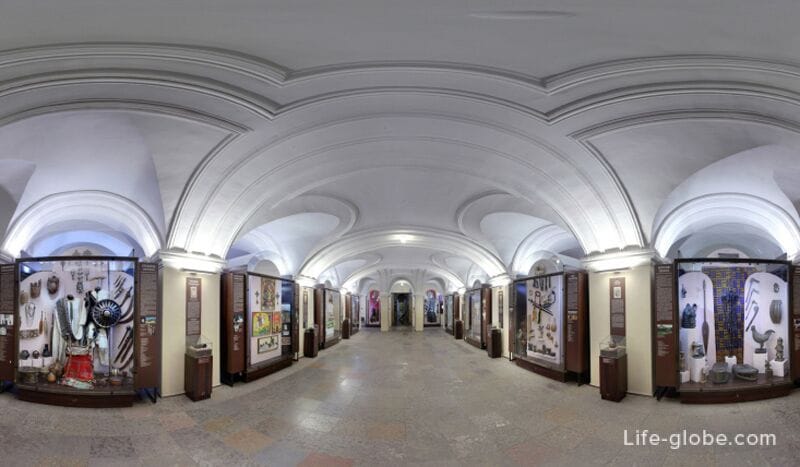
The exhibition "Japan" is dedicated to the traditional culture of the Japanese.
The exhibitionincludes: collections of agricultural and fishing implements, samples of tools and objects for the production of silk; works by Japanese artisans; models of traditional homes that give an idea of the functionality and aesthetics of the Japanese home.
Especially popular are the exhibits of the collection related to the traditional holidays of boys and girls, samples of traditional clothing, tea ceremony accessories, masks and other attributes of the Japanese theater (noh, kabuki, kagura), ancient armor and edged weapons of the samurai, objects of worship of the main religions of Japan-Shintoism and Buddhism.
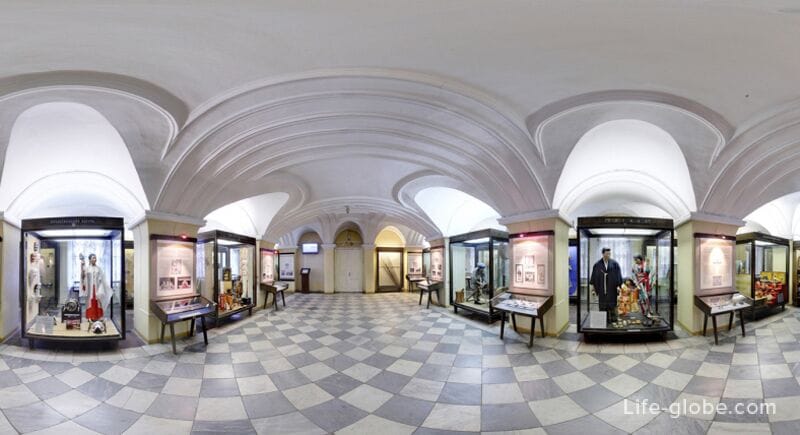
The exhibition "China" is one of the earliest and most complete ethnographic collections of the museum.
The exhibition presents: collections of art products of the 18th and 19th centuries; a collection of Chinese porcelain; collections of clothing that introduce the peculiarities of the costume of various social strata of Chinese society, the peoples of multinational China; objects of worship and funeral rites that give an idea of the diversity of religious teachings of the country's population.
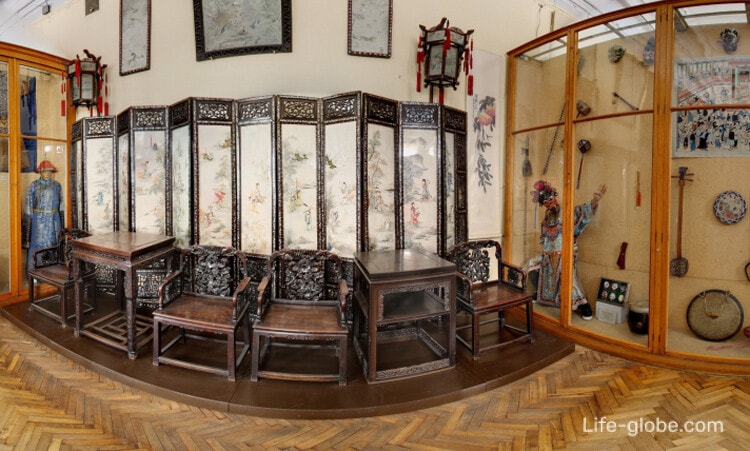
The exhibition "Mongolia" introduces the traditional clothing of the Mongols, household utensils and ornaments, musical instruments, handicrafts and objects of traditional art.
A special place in the collection is given to everyday items of cattle breeders: riding equipment, felt and leather products.
Attention is drawn to a large model of a traditional Mongol dwelling-a yurt, as well as a collection of papier-mache masks of the Tsam mystery.
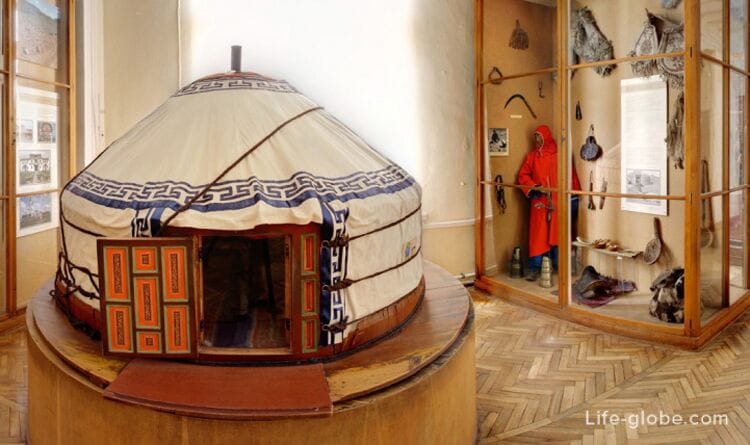
The exhibition "Korea" contains modern products and archaeological finds that illustrate the continuity of the worldview, the originality of artistic traditions and the secrets of the skill of many generations of Koreans.
The exhibition presents: collections of clothing, palace utensils, household and ritual utensils, agricultural tools and craft tools that reflect the peculiarities of the life of various representatives of Korean society - peasants, citizens, nobles and the military class.
Unique collections of antique products made of celadon, metal and white porcelain with underglaze painting are considered to be unique.
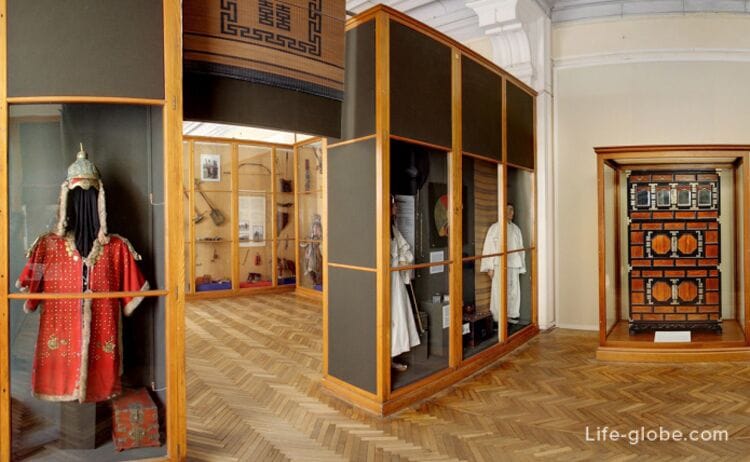
The exhibition "Indochina" introduces the culture of numerous peoples of Thailand, Laos, Cambodia, Vietnam and Burma.
The exhibition presents samples of traditional clothing and musical instruments. Interesting collections of Buddhist sculptures and ceremonial weapons from Thailand, masks of the traditional Thai theater Khon and household items, in particular - dishes.
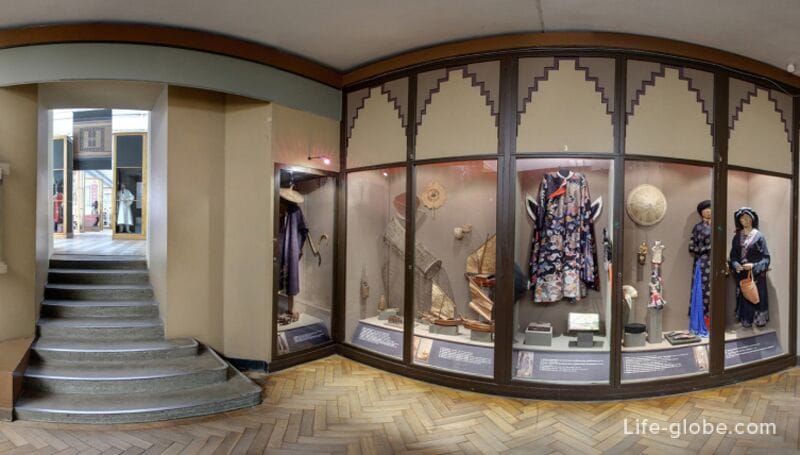
The exhibition "India and Indonesia" is dedicated to the life and culture of the peoples of India and neighboring countries, as well as the ethnography of Indonesia, - the culture and traditional occupations of the peoples of Sumatra - the Bataks and Minangkabau.
In the collection "India": Indian textiles-cotton, silk and wool fabrics, samples of naboek and stamps for them, brocade; clothing and jewelry of the peoples of Hindustan; weapons and armor, vessels and utensils; the portico of the 18th century palace of the Maratha rulers from the city of Nasik.
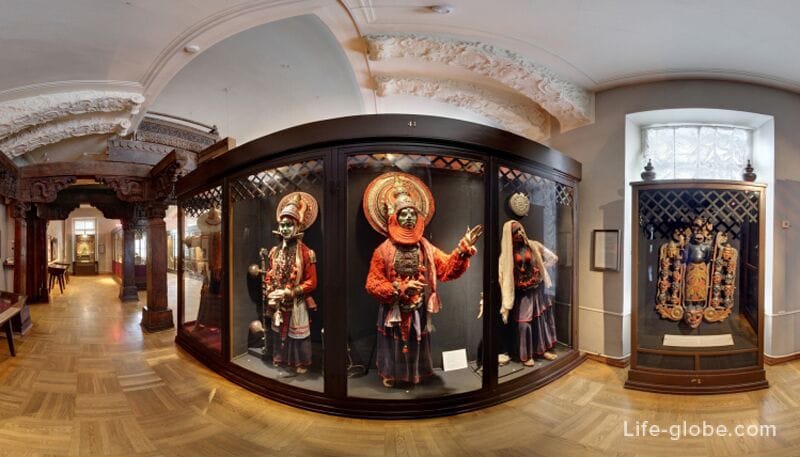
The collection "Indonesia" presents items related to economic activities and the development of crafts: weaving, blacksmithing, pottery, weaving; as well as stone figures of ancestors, "ships of the dead"," magic wands " of priests, priestly books, ritual masks and amulets.

The exhibition "Near and Middle East" presents the museum's collections on the culture of the peoples of Iran, Afghanistan, Turkey and the Arab countries.
The exhibition shows the monuments of Islamic culture, including handwritten and printed copies of the Koran, reading and writing accessories, attributes of the Shiite mystery "Moharram", samples of cold weapons, an ancient helmet, shield and parts of the costume of a Bedouin rider.
The hall also displays silks from the offerings of the Bukhara emirs to the Romanov royal family, other artistic products of the population of Central Asia, as well as some particularly bright household items of the peoples of North Africa.

The exhibition tells about the collections of the" cabinet of naturals " of the Kunstkamera and their exposure in the 18th century, including the preserved part of the collection that in 1716 Peter I purchased for the museum from the Dutch pharmacist and collector Albert Seba: a collection of preparations of exotic animals, fish, reptiles and insects, showing a huge variety of fauna of the globe.
All the exhibits displayed in the hall are somehow connected with the activities of Peter the Great - his scientific interests, plans and orders.
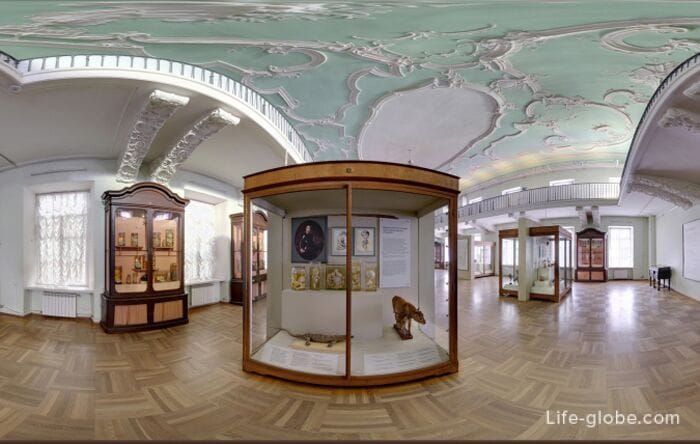
The exhibition "M. V. Lomonosov and the Academy of Sciences of the 18th century" is partially located in the tower of the Kunstkamera and tells about the early stage of the history of the Russian Academy of Sciences.
The building of the Kunstkamera in the 18th and 19th centuries housed the St. Petersburg Academy of Sciences, founded by Peter the Great, one of the first academicians of which was the Russian scientist-encyclopedist - Mikhail Vasilyevich Lomonosov.
The exhibition recreates the atmosphere of a scientific institution of the 17th century, where such world-famous scientists as N. and D. Bernoulli, J. Delille, G. F. Miller, L. Euler and M. V. Lomonosov-the first Russian member of the Academy - once worked, invited by Peter I to the St. Petersburg Academy of Sciences.
The exhibition presents: the surviving personal belongings of M. V. Lomonosov, mosaic portraits made in his workshop, unique scientific instruments and instruments of the 14th and 19th centuries, books, as well as works of painting, graphics and sculpture, decorative and applied art and furniture.

In the tower of the Kunstkamera in the 18th century, until the completion of the Pulkovo Observatory in 1839, observations were made over the starry sky, time and cartography services worked.
The exhibition reproduces the workplace of an astronomer of the 18th century. A large sliding telescope is one of the few surviving instruments of M. V. Lomonosov, with which he observed the passage of Venus across the Sun's disk in 1761.
The collectionincludes a variety of scientific instruments, measuring instruments, complex astrolabes, elegant clockwork mechanisms, spyglasses and telescopes.
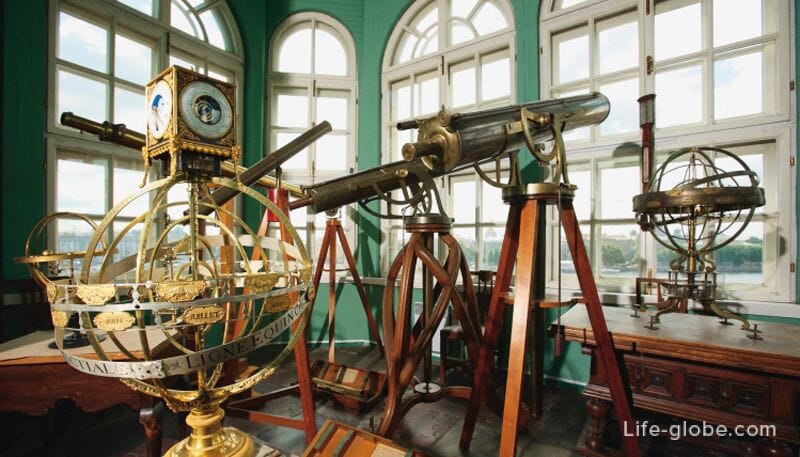
In the hall there is a Large Academic Globe, which is not original, but was re-created (restored) and repeats the size of the Gottorp globe that was damaged during the fire in 1747, reproduces the current rotation mechanism, astronomy with a map of the starry sky inside. The geographical map on the outside of the globe shows the geographical representations of Russian scientists of the second half of the 18th century.
The diameter of the globe is 3.1 meters.
Initially, the terrestrial and celestial globe was made in the Duchy of Schleswig-Holstein by the mechanic A. Busch and the engravers A. and H. The Rotgizers in 1651-1664, designed by Adam Olearius, during the reign of Duke Frederick III.
The globe was a diplomatic gift to Peter I from the Holstein Duke Karl Friedrich during the Northern War. The globe was brought to St. Petersburg in 1717 and in 1726 was installed on the third floor of the building of the Kunstkamera of the Academy of Sciences.
In 1747, the globe was damaged in a fire in the Kunstkammer: only a metal frame, a few metal parts and a door with the image of the coat of arms of the Duchy of Holstein remained. The globe was restored in 1748-1752 in St. Petersburg by mechanics B. Scott and F. N. Tiryutin, cartographer I. F. Truscott and painter I. E. Grimmel.
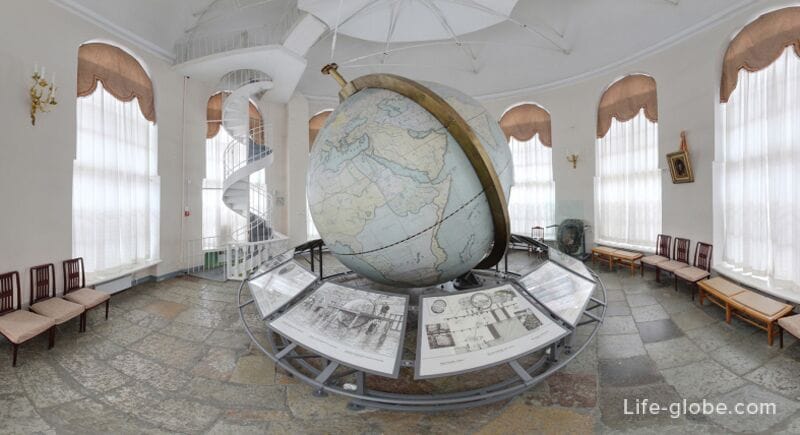
On display: M. V. Lomonosov and the Academy of Sciences of the 18th century, the First Astronomical Observatory of the Academy of Sciences and the Great Gottorp Globe, located on the 3rd, 4th and 5th floors of the Kunstkamera-entrance is possible only with the help of guides.
The museum also has rooms for temporary (rotating) exhibitions. In addition, the Kunstkamera offers guided tours, including game classes and quests.
Entrance to the museum is paid. Free admission is possible for certain categories of citizens and children under seven years of age.
The day of free admission to the museum for individual visitors is the third Thursday of the month from September to April. You can get a free ticket at the museum's ticket office.
Tickets can be purchased at the museum's ticket offices or online on the official website.
Attention! All information about the Kunstkamera-expositions, excursions, opening hours, ticket prices, free admission, conditions for visiting the museum, etc., we recommend that you check directly before visiting the official website of the Kunstkamera.
Website of the kunstkamera in St. Petersburg: kunstkamera.
You can see the famous building of the Kunstkamera on your own or with one of the excursions in St. Petersburg
Address of the Kunstkamera in St. Petersburg: Universitetskaya embankment, 3.
Coordinates: 59°56'30"N 30°18'16"E (59.941667, 30.304444).
Nearest metro stations: "Vasileostrovskaya", "Admiralteiskaya" and "Sportivnaya"
Travel directions:
- from "Admiralteiskaya": on foot 1.2 kilometers (on foot Palace Bridge) or by bus - 7, 24, 191, trolleybus - 1, 7, 10, 11;
- from "Sportivnaya": on foot 1,7 kilometers (on the Exchange bridge) or by bus - 191, 10; trolleybus - 1;
- from "Vasileostrovskaya": on foot about 2 kilometers or by bus - 24, 47.
All accommodation facilities in St. Petersburg, including in the city center and more remote from it, can be viewed and booked here